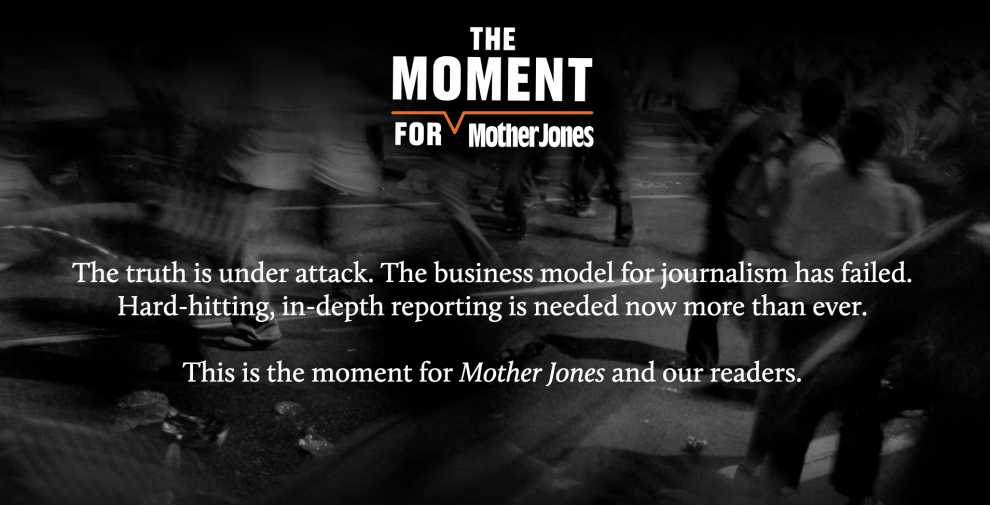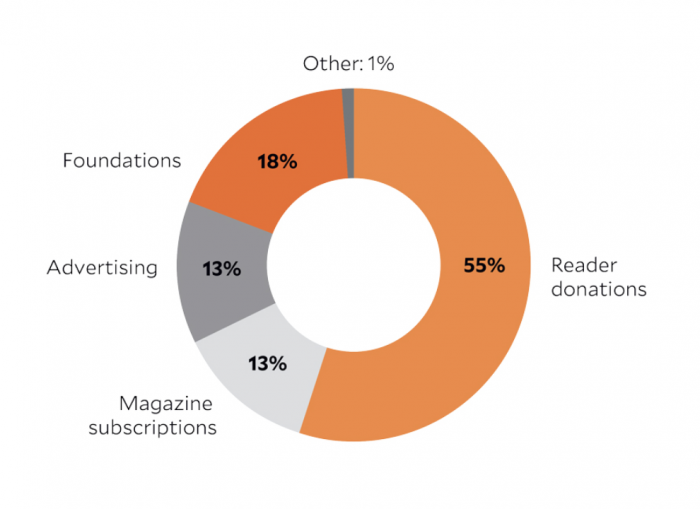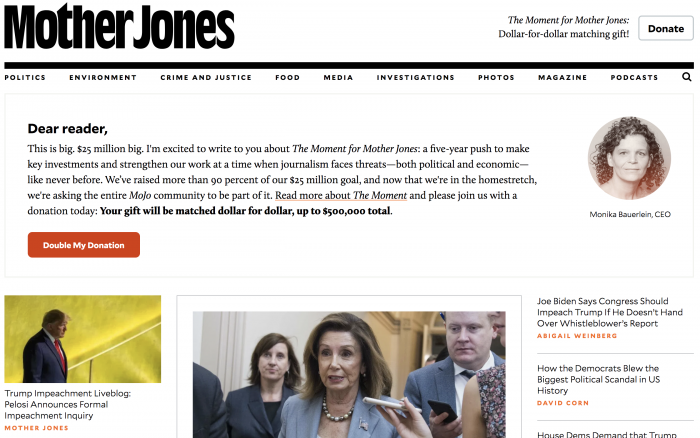
This is a story of how to turn 47 percent into $25 million.
In 2012 — eons ago in the speed of news cycles these days — Mother Jones released video of Mitt Romney at a private fundraiser claiming 47 percent of Americans were never going to vote for him because they were dependent on the government and entitlements, weeks before he lost the election to President Barack Obama. The nonprofit news outlet’s publication of the secretly recorded video set off a firestorm and set the stage for the now-43-year-old publication to transform into a news organization that could survive another four decades.
“We had a board meeting in October [2012] after the 47 percent story ran. There was a lot of celebration,” Steve Katz, now Mother Jones’ publisher, said. “The board looked at the staff and said ‘What next?’ Really, the question on the table was: ‘What could we do to increase the likelihood of a story like the 47 percent happening again?'”They could raise $25 million. (No pressure.)
The board meeting set in motion a sprawling capital campaign to raise, over almost four years, $25 million to create a safety net and innovation engine for Mother Jones’ newsroom. Some $23 million has now been contributed via The Moment for Mother Jones and this week Mother Jones’ 13-person fundraising team opened up the home stretch to contributors of any level.
“We are convinced that the traditional models of paying for high quality public service journalism have already collapsed,” Monika Bauerlein, Mother Jones’ CEO, said. “Aligning both the organization and the audience around the idea that journalism is essential infrastructure for democracy and that it has to be supported by the small-d democratic public that it serves makes it all feel like it’s all pulling in the same direction.”
But as the planning process for the campaign began, the outlet faced a defamation lawsuit from a billionaire Republican donor that left it $650,000 in the red. Bauerlein and Clara Jeffery, then co-editors (Jeffery is now editor-in-chief), wrote an essay to readers explaining that Mother Jones needed their help. Readers, who as part of the culture of the outlet had been financially supporting it since its founding in 1976, stepped up, as Nieman Lab highlighted in December 2017:“That was one of the aha moments — that piece [by Bauerlein and Jeffrey, headlined “There’s One Piece of Democracy That Fat Cats Can’t Buy” with the subhead “At least so long as you do your part”] raised a lot of money, and way more money than an ad on an article ever raised, than we thought would raise,” Brian Hiatt, Mother Jones marketing and membership director, said. “Six weeks later, we had to go right back to the well for our December campaign. Monika and I were brainstorming, and we thought, let’s just level with people and explain why we need to raise yet another $200,000-some dollars. That longform piece was the first time we really integrated with fundraising, and it worked.” It laid bare the amounts Mother Jones was raising through the week in multiple updates, including a breakdown of the percentage of donations coming from email pushes, through ads on its homepage, and via links in the longform piece.
Mother Jones already makes 55 percent of its budget from reader donations, with 13 percent coming from magazine subscriptions, 13 percent from advertising, and 18 percent from foundations. That 55 percent includes both major gifts and smaller individual donations because, as Bauerlein said, “it’s all the same impulse from the reader…It was really important to us to have the same kind of high-level conversation with somebody who gives $5 or $500,000.”

But, in any fundraising campaign, sometimes the bigger-dollar donors do get a little extra attention. Katz, the publisher, explained how he built a relationship with one big donor over the past few years as the campaign developed. The donor’s support ebbed and flowed, sometimes contributing quite meaningfully to their budget and sometimes nothing, and Katz took him to lunch to talk about the major campaign. He discovered the donor had been raised in a working class family that valued justice and equality.
“When we talk to readers and donors and supporters at the level of their values, we are engaging in a much more serious conversation about what journalism means in this society than when we skim the surface of a particular topic area or techniques or troubles with the business model,” Katz said. “Before we get to the strategy or the issues, we’ve got to have this heart-to-heart about the value behind the gift and the value of journalism as a public good that is part of what makes a community worth living in.”
As Katz worked on developing donor relationships, Bauerlein and Jeffery were strengthening the newsroom with the donations that had already come through. The organization has grown by a third, to more than 100 people, with new hires reporting on the intersection of beats like economic inequality and the opioid crisis or reproductive justice and racial justice. Mother Jones is also adding to its D.C. team, redoing its tech stack, increasing the stipends for its fellowships, and introducing a two-year residency program that will pay independent mid-career journalists to work on Mother Jones projects.
Mother Jones is aiming to wrap this campaign up by the end of 2019 to prepare for the 2020 elections as a fresh fundraising angle. In the first week of its public phase, the campaign raised $66,000 of its $500,000 goal. A “Dear reader” note from Bauerlein graces the top of each page on Mother Jones’ site right now, even its homepage:

The team hopes to raise more money for an endowment to protect the organization in case of another expensive lawsuit (they had raised $1 million for one originally but spent that down pretty quickly when the defamation lawsuit arose) and involve more volunteer supporter in the next process.
“It’s really inspiring how much people respond to a transparent and high level approach,” Bauerlein said. “The cynic would say you have to be manipulative to get people to engage with you. This model is much more about embracing the audience as a partner in the endeavor.”